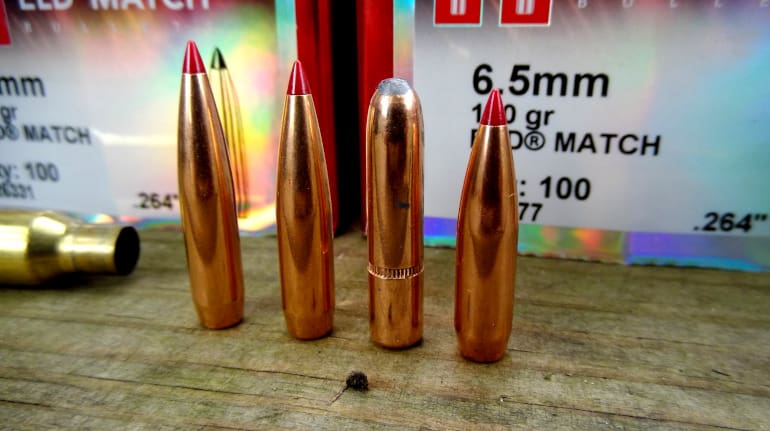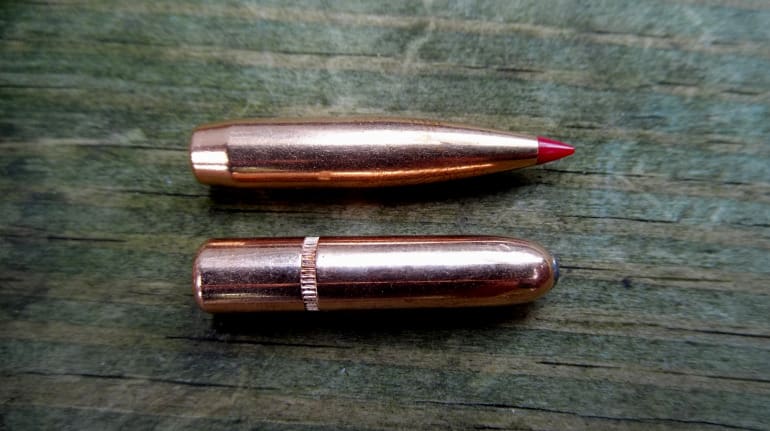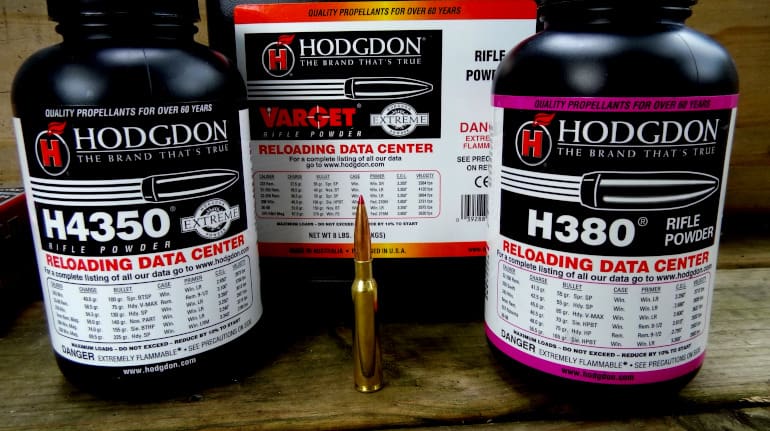Everyone gets into guns for a different reason. When I was growing up, I had many separate interests that all got focused on guns. I loved woodworking, metalworking, history, and, above all, minute details about specific things. I became fascinated by the historical markings on old guns and eventually got into collecting and shooting surplus rifles. This article is about one of those minute aspects that I love reading about: historical ammo.
Disclaimer: The load data here is for educational purposes only. Some of the loads here were developed with only approximate information and should not be attempted. I do not recommend that you try these loads yourself in any rifle. I used a longer process than this article describes to make sure they were safe in my rifle. The author assumes no responsibility for any injury that may result if you go ahead with loads anyways. Always have your gun checked by a competent gunsmith to ensure that it is safe to fire.
The 6.5x55mm cartridge is one that I have a great deal of experience with. I’ve shot it in CMP competitions for nearly ten years and have achieved great results with it. I’ve loaded a lifetime’s worth of ammo — about 10,000 rounds — with my heaviest year of shooting seeing me go through 1/3 of that. I love the cartridge and it hasn’t let me down in competition or hunting.
What interests me the most about old cartridges, the 6.5x55mm in particular, is that they can represent incredible forward thinking, innovation, and have features that are constantly mimicked by today’s most popular commercial rounds, such as the 6.5 Creedmoor. People have beaten the dead horse to the point of turning its bones into powdered aphrodisiac when it comes to today’s 6.5 rounds, and it seems like they are drinking the concoction with their morning coffee to further fuel their spiral into madness.
The 6.5×55 has seen several iterations over the years that I will be attempting to replicate with modern components. The cartridge began development as a joint Sweden/Norway effort in the early 1890s. It’s what most would consider a ‘generation 1’ bottlenecked, smokeless powder cartridge.
I used only Hornady bullets and brass and CCI #200 Large Rifle primers for all loads featured here. Powder used was provided by Hodgdon. I fired all test loads over my Oehler 35P chronograph at a distance of eight feet from the muzzle. I used a 1914 vintage M96 Swedish Mauser rifle for the testing. The gun is in like-new condition, including the bore.

Some of the first ammunition developed for the 6.5×55 was the SK PTR M/94 PRJ M/94 which had a 156-grain roundnose bullet loaded at a stated velocity of 700m/s. I have done a great deal of research in period publications and this is a common number for this velocity. American publications typically reference it at 2296-2380 fps. This is what most people reference as the ‘moose hunting load’ when they talk about the 6.5×55 in a hunting context.
For this load I tested several Hodgdon powders with the excellent Hornady 160-grain soft point roundnose bullet. This is about the closest thing you can get to the original as far as size, bearing surface, and profile. The bullet features a lead tip and is designed to expand (it’s part of the InterLock line), unlike the original military full-metal jacket (FMJ) bullet. I loaded these bullets to the cannelure. Feeding and cycling was reliable in my rifle.
I looked for historical powder charge weight for my rifle ammo test loads and came with a single reference to a weight of 36.3gr of unknown powder in an old, crumbling 1970’s-era copy of The Book of Rifles. I cross-referenced my Hodgdon reloading data and came up with one load that really matched my goals, which was a 36.0gr charge of Varget. This was a max listed load and states 2354fps from a 24” barrel. I opted to forgo the 0.3 grains and stick with 36gr with the 160-grain bullet.

I thought that the extra length of the Mauser’s 29-inch barrel would increase speed, but it didn’t go up as much as I feared. My initial test proved that my estimate was spot-on.
My first five loads over the chronograph produced an average of 2301 fps. I fired for group using my CMP shooting coat and sling at 100 yards. The ammo grouped to 2 inches for ten shots, which was wonderful. Recoil was very low and the gun was pleasant to shoot with this load.
The next ammo I wanted to replicate was the experimental FM/13 load that had a 135-grain bullet at 845m/s. The only information about this load was in metric, so I came up with a single listed velocity of 2772 fps. I selected the Hornady 130gr ELD bullet for this test. Since I had no real data to work with, I looked up data for the Hornady 129-grain soft point bullet and extrapolated on it.
There were no max loads for the 129 SP that matched or any data for the 130gr ELD boat tail bullet type, so I had to go out on my own and look for a matching load. I looked at both H4350 and H380 for this. I loaded up a small number of experimental cartridges with 46 gr of H4350 and 43gr of H380. These were loaded to 3.030” in length.
I was pleasantly surprised that my efforts paid off and I reached a velocity goal of 2790 fps for the H4350 loads and 2749 fps for the H380 loads. There were signs of pressure on these loads, but no significant cratering of the primers. Accuracy was great with both at 1.8” and 2.1” for five shots, respectively.
The next load I tried to replicate was the SK PTR M/94 PPRJ M/41. This load featured a bullet weight of approximately 113 grains, although I’ve spoken to a couple cartridge collectors that said the bullet was actually 118 grain full metal jacket. Either way, the load featured an armor-piercing projectile at a blistering 3116 fps.
I settled on the Hornady 120-grain ELD bullet for this one. I ended up testing max loads with both H4350, H380, Varget, and H4895 and wasn’t able to produce the listed velocity. The fastest load I was able to generate was with 40gr of Varget at 2875 fps. I didn’t want to push it and damage my rifle.

I called up a friend of mine with had some 100gr Hornady ELD bullets (not in the article photos) sitting around that he didn’t want to use for his rifle and I snagged twenty of them. I wasn’t ready to give up on this cool Mauser ammo load and figured that the 100-grain bullet could be used to approximate the 113-grain version of the Swedish ammo. I wasn’t disappointed.
I settled on 42gr of Varget to test it and it turned out to be a winner. I was very happy when I saw 3150 fps flash across my chronograph. They grouped 2.5” for five shots at 100 yards.

My last replica load was the SK PTR M/94 PRJ M/41 PRICK. This is the ‘sniper load’ that was used in WWII Sweden. It featured a 139.97-grain FMJ bullet loaded at 2600 fps. The listed powder weight I found for this load was 37gr, but I didn’t see a load that would exactly match that among Hodgdon’s listed powders at that charge weight. I instead looked to get close and tested Varget (38gr), H380 (40gr), and H4350 (44gr).
I ended up landing right around my goal area on these. Varget at 38gr got me 2590fps, H380 at 40gr reached 2540fps, and H4350 landed at 2614fps. I called the last one good and shot it for group. This rifle cartridge managed 1.75” at 100 yards for five shots.
Overall I was happy with my replica loads. It’s fun to test ammo and powder that closely resembles what was used back then. My favorite was the 160-grain RN big game load, as it was just so fun to shoot and I got lots of interested looks at the range.
If you’re looking for some fun ammo projects to work on, visit www.hodgdonreloading.com and www.hornady.com to see what I think are the best in bullets and powder.
If you want to try some commercial ammo for sale in a gunsmith-checked rifle prior to jumping in on the hand loads, the 6.5×55 Swedish ammunition is widely loaded, including by manufacturers such as Remington, Winchester, Sellier & Bellot SB6555B, Norma, Lapua (123-grain Boat Tail Hollow Point [BTHP], 100-grain hollow point boat tail HPBT, 120-grain hollow point), and others, such as Fiocchi, Prvi Partizan (PPU PP6SWF), Federal Fusion and Federal Power-Shok, and Nosler. To answer FAQs about case dimensions, SAAMI-approved chamber drawings are here.





One of my friends shoot a record Sambar deer with 6.5 mm Swede in 1982. He usedbthe 1942 semi auto version but only needed one shot with factory 140 gr round. He also had three of the bolt actions but went with the semi as Sambar usually live in very thick brush.
As Josh said a very effective round.
Those round-nose pills just look flat *evil*.
“I ain’t pretty. I’m big, heavy, and I’m gonna knock you flat on your ass with a wicked, heavy punch.”
Like thick-necked Guido coming to collect the money you owe him…
Very smooth shooting round that is hard to find Ammo for. Hand loading is the perfect solution
Could you do 7×57 next?
Great info. I’ve thought about working up a target load using some nice HPBT bullets, but my M96 really likes 139 gr Prvi Partisan SP rounds, so I wonder if it’s even worth the effort. Then again, spending time behind a Swedish Mauser is always worth it. Such a fun gun to shoot.
Very cool, makes me want to get loading on some of my rifle stuff. This is a quintessential European hunting round, but then again people only realized 6.5mm was cool in the states recently. 🙂
The Norwegian/Swede answer to the question was a 140 grain bullet at a modest 2,400 feet per second for hunting medium game or warfare.
Nobody has really found a better alternative to this day.
6.5×55 Grandpa Creedmore
I call it 6.5 Swedemoor.
Great article; I get the most fun out of loading Paper Patched 500 to 540 grain RN lead slugs I extrude using an old rockchucker press I use them at long (up to 600 yards) ranges in my Winchester 1885 in 45-90 or in my Grandfathers 1886 in 45-70 out to 150 yards with RN-FP versions I use Real Black Powder for these loads and I hunt with the 1886 Winchester with them as well…. Paper Patching basically vanished with the advent of copper jacketed slugs and the fun involved dyeing this old tech If a major factor for me in developing loads as there is so little modern information about it… things like why high rag content paper is so important for good results and why swiss black powder is so much better than Goex.
Nice article. Love the Swede bolt guns. In Soldier of Fortune Magazine, October 2001, “Keep ‘Em Shooting” section is an article on the rifle and the cartridge including reloading data. Text and photos by a Steve Comus.
Great article! I realize that reloaders don’t compromise significant part of ttag readership, but those of us who pursue the “other half of shooting” sure appreciate this kind of info. Keep it coming.
The 6.5 x 55 MM, like the 7 x 57 MM Mauser always were, and remain so to this day, very good rounds.
Comments are closed.